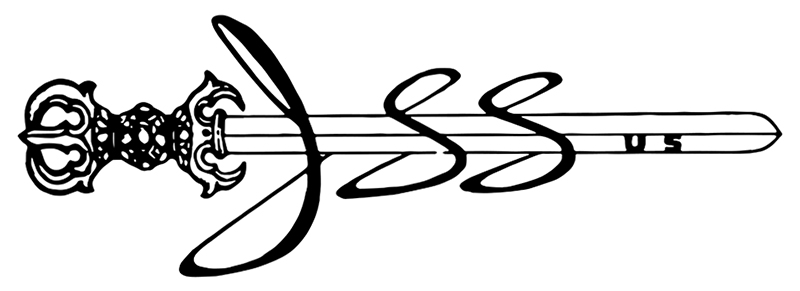
The articles on this page originally appeared in JSSUS newsletter Volume 9, no.1, 1971. Page 17
JAPANESE SWORDS IDOLIZED BY JAPANESE WOMEN
by Naohiro Takahashi
JAPANESE SWORDS IDOLIZED BY JAPANESE WOMEN (Translation of an article from Mainichi Graph, a Japanese magazine, 1969.)
by Naohiro Takahashi
A new Japanese Sword Appreciation Society has been formed with members totaling over 200, all due to the current "Sword Boom". This newly formed society claims that the "Price of the Samurai Soul has gone up".
Present day bank interests on regular saving deposits in Japan is 5.5%, 7.7% on large and long term saving deposits. Prices of land and buildings are also going up, but in comparison with profits or gains from bank deposits and real estate transactions there is a special investment one can make that has a return of 20% or better in the space of one year. This is done by buying and selling Japanese swords.
Prior to the Japanese sword interest, the Japanese housewives considered art objects and jewelry as being valuable and profitable as investments for the future, thereby creating a great demand for these luxury and priceless items. Now the Japanese sword has captured the fancy of the Japanese housewives. The housewives are hoarding Japanese swords in place of their "pin money" to meet future emergencies or so called "rainy day predicaments". Based on the economic principle of supply and demand, the price of Japanese swords will continue to soar thereby making it a foolproof means of investment with large returns.
When late President Suharto of Indonesia was asked by Prime Minister Sato of Japan what he wanted most as a gift from Japan, he replied, "A Japanese Sword!" This goes to show that the Japanese sword is a much sought after gift of foreigners. Mr. Yamagata, a well known sword polisher in Shinjiku Tokyo receives many orders from abroad to have blades polished and serviced. He receives more than twenty polishing requests per month from foreigners alone. These numerous requests to have blades polished from abroad shows the popularity and interest shown among the foreign collectors.
Based on the figures that there are 1,300,00 to 1,400,00 Japanese swords in existence today; sword collectors and brokers will increase. The popularity and demand for Japanese swords will also cause the prices to rise and meet the demand. In 1954 national treasure class swords could be bought for a mere 5-600,000 yen (Approx. $1550 to $1620). Munetsugu and Naokatsu, both important cultural property class went for 100,000 yen, approximately $270. In 1960 when the economy of Japan became more stabilized the value of swords started to climb upwards.
According to Mr. Mitsuo Shibata, official of the National Sword and Cultural Art Objects Preservation Society, the price of Japanese swords are low in comparison to art objects and jewelry. In many instances it takes a master craftsman and his helpers a long time to make a good sword. This does not take in the polishing and making of special scabbards with sword furniture to match. The price of swords is so stable now that it will never go down but it will keep on going up instead.
Japanese sword collectors and appreciation clubs are found all over the world. A sword maker's name guessing game is held by these clubs from time to time. The players or contestants are given unsigned blades or blades with covered tangs so as not to show the signature. They vie with each other to see how close they can guess the name of the swordsmith. The women members are on the increase in the formerly male dominated All Japan Japanese Sword Fancier Club.
One can double his investment in a three-month period with a Japanese sword! This really happened to a Japanese housewife so the story goes. A certain housewife by the name of Mrs. Reiko Mitsuhashi chuckled to herself the other day and wondered whether her money making secret will be exposed to her husband.
One day she saw an unsigned blade priced at 130,000 yen at an antique shop and because it looked so well-made she bought it. She used her "pin money" to purchase it. After she had purchased it she had several sword collectors and appraisers examine it to determine who the unknown swordsmith was. She received a certificate which in part classified her sword as being in the valuable sword class. A buyer appeared and offered her 300,000 yen for the blade from the Yamashiro province. She didn't know whether she should accept his offer or keep the sword. Mind you, the sword she bought three months ago for 130,000 yen has increased threefold to 300,000 yen. This was her secret.
Mr. Ichikawa, a government employee, takes his vacation every year to explore the provinces where swords were originally made. Because of his annual pilgrimage to explore the former sword making provinces, he became known as a sort of an er- satz "Don Quixote" or "Toyotomi Hideyoshi "both afflicted with the wanderlust sickness. According to Mr. Ichikawa, during the 1970 Fair in Osaka, many sword collectors from foreign countries flocked to the antique shops looking for Japanese swords. They bought most of the existing better swords leaving behind the poor blades. He felt sad and dejected because the good swords were being lost to the foreigners who were taking them back to their countries. In May 1970, the National Japanese Sword and Related Items Preservation Society officially opened their Sword Museum in Yoyogi, Tokyo, It will be the biggest museum of its kind in the world. Recognition of the Japanese Sword as objets d'art will be greatly strengthened.